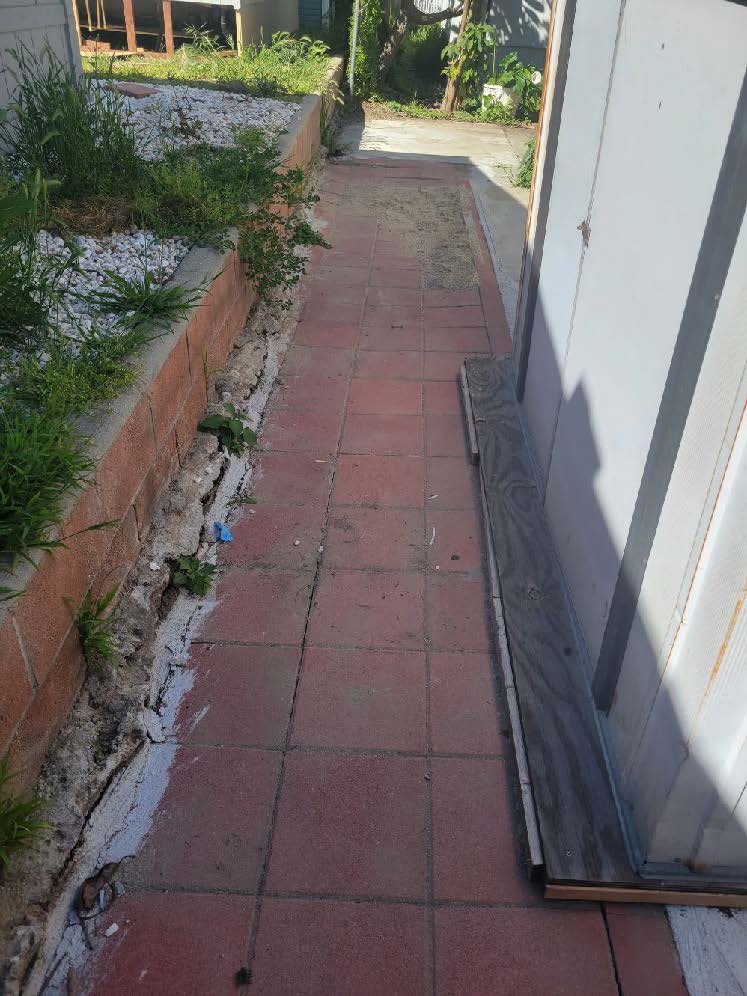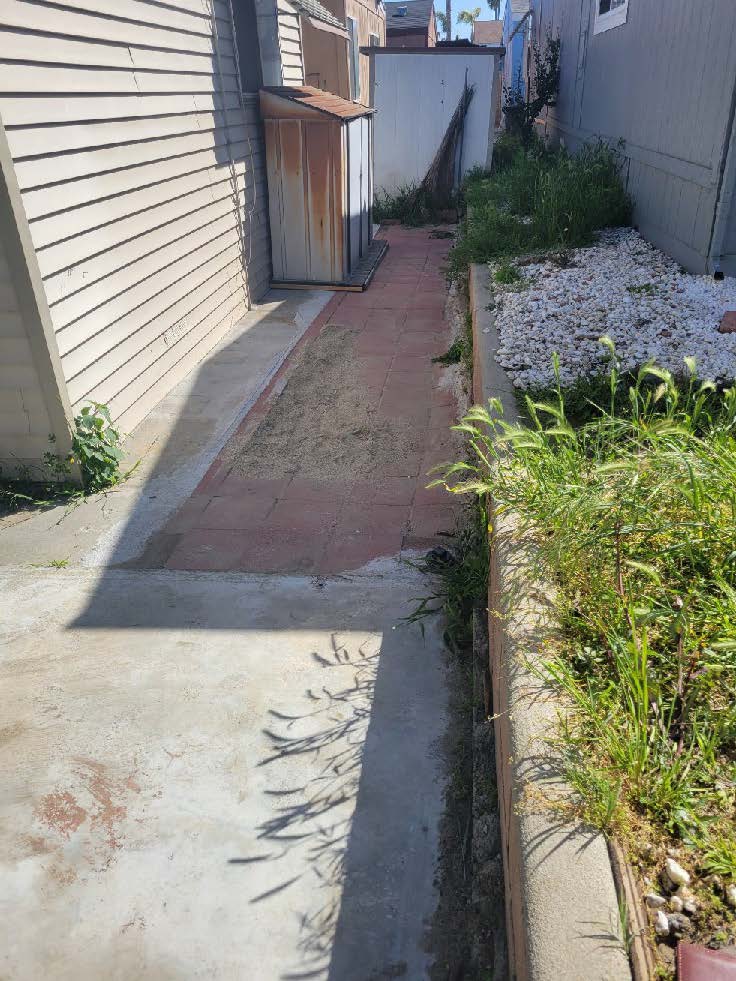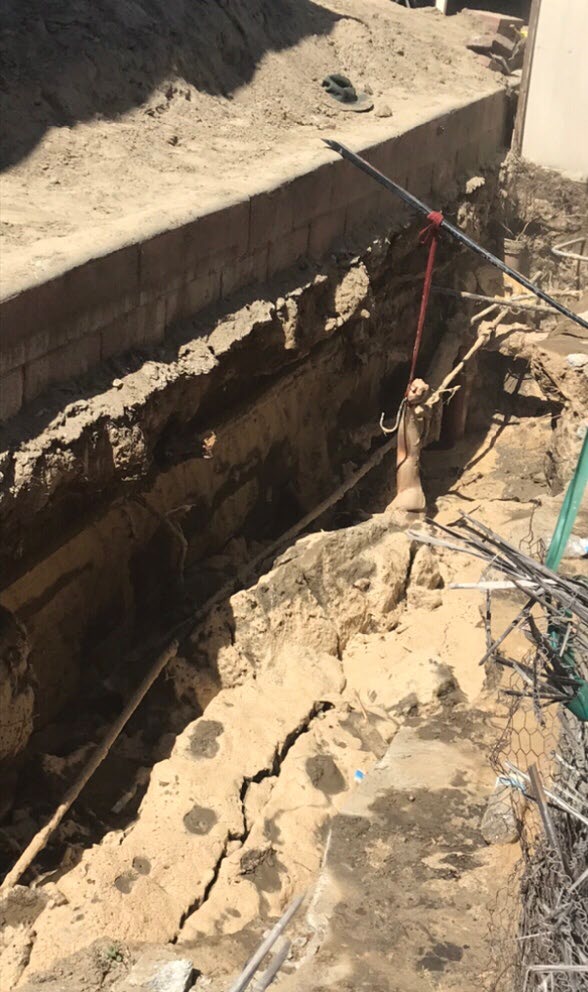Case Report: 22CA003
Day Laborer Dies in a Collapsed Trench Being Dug to Repair a Sewer Line
Download a PDF to print this report: Day Laborer Dies in a Collapsed Trench Being Dug to Repair a Sewer Line (22CA003, PDF)
Summary
On September 14, 2022, a 34-year-old Hispanic day laborer, along with three other day laborers, dug an eight-foot-deep trench to expose a damaged sewer line. Unexpectedly, while digging, they exposed and broke a water line. Water and dirt filled the trench and created a thick mud. The victim became submerged under the mud and was unable to be extracted by co-workers or rescue personnel.
Introduction
On Wednesday, September 14, 2022, at approximately 11:30 a.m., a 33-year-old Hispanic day laborer (the victim) was asphyxiated inside an eight-foot-deep trench that was being dug to repair a sewer line in a mobile home park. The CA/FACE investigator received notification of this incident on September 19, 2022, from the weekly occupational fatality summary from the California Department of Industrial Relations Public Information Office. Contact with the employer (a plumber) was made by the CA/FACE investigator on October 26, 2022. The CA/FACE investigator interviewed the plumber and the owner of the mobile home park about the incident. The police and fire department reports (including co-worker statements) were received and reviewed.
Employer
In this incident, the mobile home park owner told the property manager to contact the plumber, who was on retainer at the trailer park, to fix the problem with the sewer line. The plumber (employer) then hired four day laborers from a local home supply store, one of whom was the victim. The plumber did not have a state-issued plumbing contractor’s license (C-36). The plumber had been self-employed since 1993 and had no employees. The plumber’s primary language was English, but he could speak some Spanish. He had performed maintenance and plumbing work for several years at the mobile home park. It is not known if the plumber had performed sewer repair and/or trenching work prior to the incident.
Written Safety Programs and Training
The plumber did not have a written safety or injury and illness prevention program (IIPP). No formal training about trenching was provided to the victim. It is not known if the property owner had procedures or protocols to identify and hire a plumbing contractor qualified to perform sewer repair.
Worker Information
The victim was a 34-year-old male Hispanic day laborer who was hired by the plumber to dig a trench to expose a sewer line that needed repair. Three other day laborers were also hired by the plumber for this task. The victim’s primary language was Spanish. It is not known what prior work the victim had performed, or how much experience he had in trenching and safety procedures.
Incident Scene
The incident scene was a walkthrough between mobile home residences where a trench was being dug to repair a sewer line (Exhibits 1 & 2). The trench was parallel to a mobile home and approximately four ft. wide, 30 ft. long, and eight ft. deep. There was also a water line in the trench (running parallel) approximately three feet below surface level.


The incident location looking east (Exhibit 1) and looking west (Exhibit 2). At the time the photos were taken, the trench had been covered with tiles and concrete. Photos by CA/FACE program.
Weather
The weather on the day and time of the incident was approximately 75 degrees Fahrenheit, with a southernly average wind speed of about 7 mph [Weather Underground]. The weather is not believed to have been a contributing factor in this incident.
Investigation
Sometime prior to the incident, tenants of the mobile home park notified the property manager about a sewer line problem. According to the plumber, he was asked by the property manager to perform the repair and began trenching work to uncover the sewer line on September 12, 2022. No permits were obtained from the local municipal authorities, as is required. The plumber hired four day laborers to dig the trench. Because of restricted space, the trench had to be dug with shovels. It is not known if the plumber knew the depth of the sewer line, soil composition, and presence of other utilities (including water lines), or how he identified the location of the sewer line. The trench was dug without shoring. The plumber was onsite, but not at the location of the sewer line when the incident occurred. In the process of digging the trench, a three-inch water line was exposed that was approximately three feet below grade and ran the length of the trench. No attempt was made to shut the water line off before work began, or once it was uncovered. At approximately 11 a.m., as two laborers were in the trench about eight feet below grade, the exposed water line above them suddenly broke and began filling the trench with water and dirt that was being knocked loose from the pressurized water. When the two day laborers above the trench witnessed this, they immediately attempted to rescue their co-workers. The water and mud were already up to the chest of the trapped laborers when the two co-workers above the trench tried to pull them out. It took approximately ten minutes before one of the laborers was pulled from the mud-filled trench. Unfortunately, the victim was completely submerged under the water and mud and was not able to be lifted out by co-workers (Exhibit 3). There was an unsecured ladder in the trench for egress and ingress, but it was not able to be used in the attempted rescue of the trapped workers.

Exhibit 3. The trench after the water was removed. Photo by CA/FACE program.
Multiple fire and rescue departments arrived on the scene. The fire department removed the water from the trench with a vacuum. The victim was finally extracted from the trench after eight hours and pronounced dead by paramedics.
Cause of Death
The county coroner listed traumatic asphyxia as the cause of death.
Contributing Factors
Occupational injuries and fatalities are often the result of one or more contributing factors or key events in a larger sequence of events that ultimately result in the injury or fatality. CA/FACE investigators identified the following issues as key contributing factors in this incident:
- Lack of competent person onsite.
- Permits were not requested or issued for the work being performed.
- Workers were in an eight-foot-deep trench with no shoring.
- Water line was not turned off before or during work.
- Lack of training for workers in trenching safety.
Recommendations/Discussion
The CA/FACE investigator determined that, in order to prevent similar incidents, property owners and plumbing contractors should:
Recommendation #1: Ensure that trenches five feet deep or greater are properly shored, shielded, or sloped.
Discussion: In this incident, the victim was working in an unprotected trench with a depth of eight feet. Any employee in a trench, five feet deep or more, is required to be protected from cave-ins by an adequate protective system. For all trenches or excavations five feet or deeper into which any person is required to descend, Cal/OSHA requires a permit. For any trench at risk of cave-in, Cal/OSHA requires sloping, benching, shoring, or shielding to protect workers from cave-ins.1 A qualified licensed contractor will also ensure that trenches five feet deep or more are properly shored, sloped, or shielded. The type of protective system, support system, or shield system used would be determined by the soil conditions found in the excavation. This is usually determined by the employer, competent person, or a licensed engineer. In this incident, the protective system should have included a trench shield (also known as a trench box), shoring, or a combination of shoring and shielding. Sloping would not have been appropriate because of the limited space within the motor home park. Employers can also consult tables located in the appendices of the Cal/OSHA Excavation Standard (CCR, Title 8, Subchapter 4, Article 6) that detail the protection required based upon the type of soil and environmental conditions present at the site. In addition, employers can consult with manufacturers of protective systems to obtain detailed guidance for the appropriate use of this equipment. In this incident, no protective system had been placed at any point in the trench. Had the trench been properly shored or shielded, this incident could have been prevented.
Recommendation #2: Ensure that the trench is inspected by a competent person.
Discussion: Many hazards are associated with excavating and trenching operations, including cave-ins and
changes in environmental and physical conditions. Contractors who are licensed to perform excavation and trenching work are required to have a competent person who performs the necessary daily inspections of excavations, adjacent areas, and the protective systems that are necessary and required. When employees are required to work in trenches deeper than five feet, a competent person is required to be onsite. Cal/OSHA defines a competent person as “One who is capable of identifying existing and predictable hazards in the surroundings or working conditions which are unsanitary, hazardous, or dangerous to employees, and who has authorization to take prompt corrective measures to eliminate them”
In this context, a competent person has:
- Knowledge of all safety requirements pertaining to excavations, trenches, and earth work.
- Knowledge of the soil analysis of the work site.
- Knowledge in the requirements for and use of protective systems.
The authority to take prompt corrective action on the job as conditions warrant.
A competent person must also inspect the trench and protective systems daily before the start of work and throughout the day as conditions change. In this incident, the plumber was not a competent person or knowledgeable about the proper procedures for trenching. Had a competent person been onsite and made daily inspections, the workers would not have been allowed to enter the unprotected trench and continue working with a pressurized water line exposed, possibly preventing this incident.
Recommendation #3: Ensure that a licensed plumbing contractor is used to perform trenching and excavation work.
Discussion: In this incident, the property owner of the mobile home park hired a plumber to repair an underground sewer line. The plumber was not a licensed (C-36) plumbing contractor, and his primary responsibility over the years was to perform general plumbing maintenance for the mobile home park. The plumber did not request or obtain a permit from the local public works department to proceed with the excavation. In this incident, the plumber proceeded with the trench excavation without adequate knowledge of appropriate safety procedures or assessment of underground utilities including water lines. The trench was excavated to a depth of eight feet without shoring, and the water line was not shut off. If a trench is planned, it is necessary to shut off all utilities near the trench before the start of work. If the property owner had hired a licensed plumbing contractor to perform the sewer repair, a permit would likely have been obtained, proper shoring would have been used, the water line would have been shut off, and this incident could have been prevented.
Recommendation #4: Ensure that day laborers are properly trained on hazards associated with working in a trench
Discussion: In this incident, the day laborers hired by the plumber were never properly trained on the hazards of working within an unprotected trench. Day laborers are workers who meet at well-known locations, usually public street corners or commercial parking lots, and wait for building contractors, landscapers, homeowners, and other potential employers to offer work. Day laborers include undocumented immigrants who are unable to gain formal employment because of their legal status. Day laborers often are in the position where they need to perform any work regardless of potential hazards that may be present on the job site and may not be aware of or able to notify their employers if they are concerned about working conditions. Most day laborers have received little, if any, safety training in the work they are hired to perform.
Employers who hire day laborers to perform hazardous work are responsible to provide them with a safe and healthy work environment. If an employer hires a worker, they are also responsible for providing workers’ compensation insurance. They must also ensure that day laborers are capable of understanding and performing all the safety aspects related to their work. Organizations that offer workplace safety training to day laborers include the Construction Safety Council (CSC), La Raza Centro Legal Program in San Francisco, the City of Los Angeles Day Laborer Centers, Instituto de Educación Popular del Sur de California (IDEPSCA), and the National Day Laborer Organizing Network (NDLON). Day laborers who have undergone such training are more likely to be familiar with and implement safe work practices. Likewise, property management companies who use licensed contractors for the specific type of work to be performed are more likely to be assured that employees are trained and are familiar with safe work practices. Employers should ensure the understanding and implementation of safe work practices by employees, including testing and on-the-job observation. (T8CCR §3203. Injury and Illness Prevention Program).
Employers who hire non-English speaking workers should identify the languages spoken, and then design and implement a multiple-language safety program for employees. The safety program should be developed at a level that corresponds with the language and literacy level of the workforce, and in a form and manner that the workers understand. This program should explain a worker’s rights to protection in the workplace, safe work practices workers are expected to adhere to, specific safety protection for all tasks performed, ways to identify and avoid hazards, and who they should contact when safety and health issues arise.
Disclaimer
Mention of any company or product does not constitute endorsement by CA/FACE and the National Institute for Occupational Safety and Health (NIOSH). In addition, citations to websites external to CA/FACE and NIOSH do not constitute NIOSH endorsement of the sponsoring organizations or their programs or products. Furthermore, CA/FACE and NIOSH are not responsible for the content of these websites. All web addresses referenced in this document were accessible as of the publication date.
References
Tailgate/Toolbox Topics-Trenching Safety (PDF), Division of Occupational Safety and Health California Department of Industrial Relations TT-8: Revised May 2011
Cal/OSHA - Title 8 Regulations
T8CCR §341. (d) (5) (A) Permit Requirements. Oakland, California. Cal/OSHA/Division of Occupational Safety and Health.
Investigator Information
This investigation was conducted and authored by Hank Cierpich, Fatality Investigator/Consultant. Additional contributions to the report were provided by Robert Harrison, MD, MPH, CDPH FACE Project Officer; Laura Styles, MPH, FACE Research Scientist; and Glenn Shor, PhD, Cal/OSHA CFOI Program.